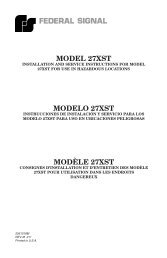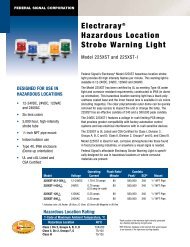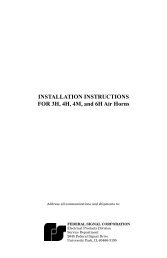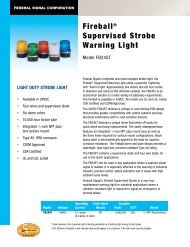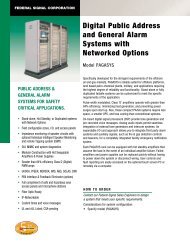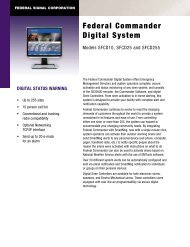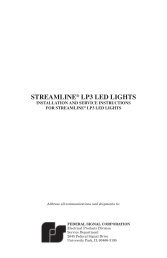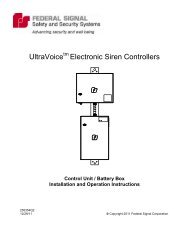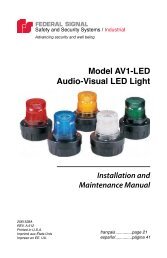SFCD: Federal Commander Digital System - Federal Signal
SFCD: Federal Commander Digital System - Federal Signal
SFCD: Federal Commander Digital System - Federal Signal
You also want an ePaper? Increase the reach of your titles
YUMPU automatically turns print PDFs into web optimized ePapers that Google loves.
<strong>Federal</strong> <strong>Commander</strong> <strong>Digital</strong> <strong>System</strong><br />
The CCU provides the operator interface to the siren system and serves as its command center.<br />
It is used to control sirens, command displays and printouts, and to store all incoming alarm<br />
messages and status messages for later retrieval and analysis. Also the CCU can be used to<br />
initiate communications with the RTU(s) to obtain status data and to program sirens remotely.<br />
For permanent records, the CCU data can be printed out on any printer which can reproduce the<br />
entire ASCII character set as well as dot addressable graphics.<br />
The CCU is the control station workhorse of The <strong>Commander</strong>. It serves four major roles: (1) as a<br />
control console to activate the RTUs; (2) as a data storage site to collect status and alarm data<br />
from all RTUs in the field network; (3) as an action station to alert key support personnel that an<br />
alarm has been triggered at some RTU, that an RTU has failed to respond to a command, or that<br />
an RTU's main power has failed and (4) as a programming console to configure radio<br />
communications parameters and remotely program RTUs.<br />
The CCU can be configured to automatically poll all the RTUs under its command for status data,<br />
on any schedule. Incoming messages to the CCU are stored on the CCU's hard disk, along with<br />
complete identification of the originating RTU.<br />
The CCU can be configured to automatically activate the RTUs under int‟s command on any<br />
schedule.<br />
An incoming message that is interpreted as an Alarm such as; Loss of primary power or Local<br />
Activation, can be configured to initiate a unique automatic telephone Alarm Call-out system<br />
contained in the CCU. This system can dial up to ten pre-assigned telephone numbers and report<br />
the alarm conditions to a key support person in an electronically stored human voice. When the<br />
call is acknowledged, the CCU discontinues further Call-outs until a new alarm condition occurs.<br />
Users may also dial into the CCU to retrieve current Alarm messages over the phone.<br />
The system also supports remote control and maintenance support over a standard phone line.<br />
Users may dial into the CCU from a remote computer to control and monitor all portions of the<br />
system. Maintenance personnel may dial into the system to provide remote service and support.<br />
All dial in features may be password protected and encrypted.<br />
SS2000D Description<br />
The SS2000D serves as the interface between the CCU computer and the radio transceiver. It<br />
also functions as a stand alone terminal unit with activation and status reporting capability in case<br />
of a PC failure. The SS2000D communicates with the CCU computer over a standard RS232<br />
serial port. Further details of the SS2000D are included in the SS2000D product manual.<br />
A complete <strong>Commander</strong> system may contain multiple base stations (CCUs and/or SS2000Ds).<br />
Each base station is addressed as a Primary or Secondary site. RTU initiated transmissions (e.g.<br />
Intrusion, Power Fail) are sent to the last Primary base station to poll the RTU for status. RTU<br />
initiated transmissions are never sent to a Secondary base station. A typical system consists of<br />
one Primary base station for system management, and several SS2000D Secondary sites used<br />
as remote activation points. All base stations in the system will receive alarm messages and poll<br />
response data sent from RTUs by eavesdropping, even if set to secondary address.<br />
IMPORTANT NOTICE: The encryption scheme used to secure data transmissions includes the<br />
time of day in encryption calculation. All activation points must have their internal clocks set to<br />
the same time (within +/- 90 minutes) in order to activate the system.<br />
20<br />
Introduction




